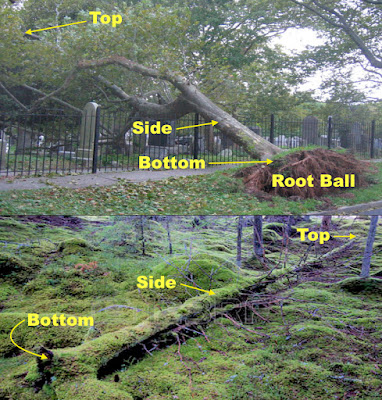The question is, how a round tree can have sides, and when felled can have a top and bottom. Even more specifically, how does the terminology apply: “Behold, thou shalt make a hole in the top, and also in the bottom; and when thou shalt suffer for air thou shalt unstop the hole and receive air. And if it be so that the water come in upon thee, behold, ye shall stop the hole, that ye may not perish in the flood” (Ether 2:20).
Perhaps a better way to read this area in the scriptural record is to take this out of the realm of personal opinion and place it in the factual world of dendrology, arboriculture, silviculture, and forestry:
1. While a tree is standing and almost at all times while referring to the trunk (stem) as a “tree,” it is referred to as “top” and “bottom,” i.e., what is up a in the sky (crown) and what is at the bottom (base) or down in the earth (roots)—even after being cut with the Misery Whip (12-foot long hand saw) and laying on the ground (liggja) since the top and bottom (once logged [cut] this is called the “butt”) are still recognizable (thus, the terms “trim the top” (topping) “trim the bottom” (bottoming); “trim off the limbs (delimbing, limbing or stripping)
3. If the ends are trimmed (rarely), and cut for putting into the ground or planting upright (such as in making a stockade or defensive fence or wall), it is called “peaking” or giving the end a “peak” (i.e., a point).
Reader: “Also, verse 17 describes sides. I struggle to see how the word "sides" fits with the picture of the barges on page 146.”
Response: All trees have sides, which differentiates that portion of the tree from the top and bottom. The side is sometimes called the “face” or “back,” but far more often called the “side.” Even though the side of a tree is continuous, as in “round,” it is still called a side, as in “side-cut” (cutting side of tree), “backside-cut” (opposite side), “offside” (opposite side), “side-binding” (cutting side of tree with other side compressed), “side-boring” (method of cutting), “side lean” (learning force), “side-notch” (side saw cut), “wood on either side of the tree,” “head lean (forward) and side lean” (side of tree), “side of limb or bottom side of limb,” “tree compressed on one side and tensioned on the other side,” “saw into the side of the tree,” “scale one side of tree,” “opposite sides of the tree,” etc., etc., etc. It might be of interest to know that in modern nuclear submarines, which are basically a round tune in design, are still referred to as having sides. Even a pencil, which is round, is referred to as having sides, as in “the side of the pencil.”
Top: A still living tree that was
recently uprooted—it is still easy to see the top and bottom, etc.; Bottom: A
long dead, delimbed tree—it is still easy to see the top and bottom
Response: First, the Lord, who knows all things, knows more about trees than any of us ever will in this life, so we have to understand he is speaking from a point of knowledge we have not attained. Secondly, while the top of a tree is called the crown, which most of us would call the “top,” yet, that term applies only to the limbs and leaves at the top, not the trunk or what we might think of as the top of a tree.
Thirdly, the length of most anything basically has a top, middle and bottom. In the case of objects of certain sizes, like pencils, trees, submarines, etc., there is also the “end.” Thus we find three descriptions—a hole in the top, a hole in the bottom, and the ends peaked (Ether 2:17). Perhaps the best way to understand this, is to consider how you would describe it without using many words (engraving on metal is a slow and laborious process, and one that cannot be corrected or changed afterward).
Though a submarine’s design is basically
round, it has a front (bow), a rear (stern), sides, top and bottom; but when a
tree in that sense, it has a top (front), bottom (rear), and sides
Nephi was shown a vision in which he saw the tree of life, the iron
rod, the fruit, the chasm and stream of dirty water and the big and spacious
building and the people inside mocking those on the straight and narrow path.
All of this was shown to him in some fashion where he could actually see these
things rather than just being told about them
Nephi also made it clear that all that was given him was done so in a vision, i.e., he actually saw what he later wrote about: “I make an end of speaking concerning the things which I saw while I was carried away in the spirit; and if all the things which I saw are not written” (1 Nephi 14:30). Obviously, a vision provides visual understanding above just wordage. What Nephi was shown, and what the brother of Jared was shown, were real images in some fashion where they could see and learn very quickly what was being told them. This is what allowed the brother of Jared to make his barges, and Nephi later, to build his ship. These were instructions embedded visually in the minds of these men to a degree as to allow teaching that had such a degree as to allow them to do things they had never before done.










A traditional village which includes the council house, two summer houses, two winter houses, a corn crib, ceremonial mound and traditional stockade fence
ReplyDeletebuilding a wood fence
Alex: Try that again....???
ReplyDelete